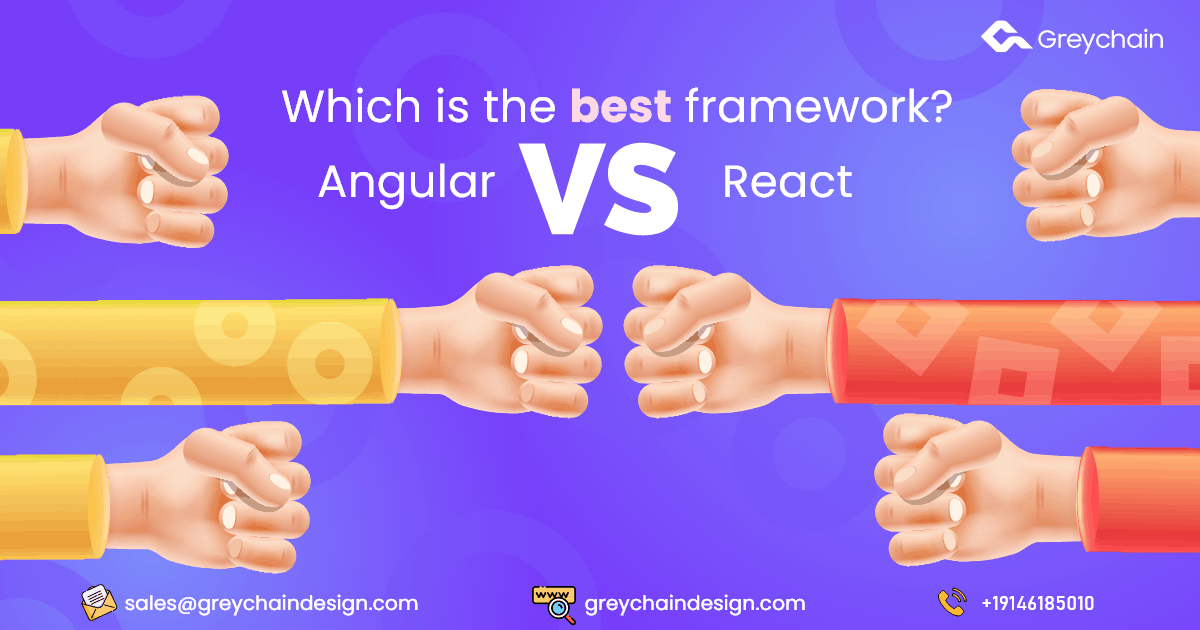It is 2021 and there are a lot of popular technologies which have been used by different app developers to build specific web and mobile applications. When we look at modern apps, we certainly get impressed by the open-source javascript frameworks that they are using; mainly React and Angular.
So, how do you choose a framework for app development?
There is always a hesitancy to choose from Angular vs React, and we can completely understand the reasons. Besides, there are many resources over the internet which explain both technologies but fail to make an impact with proper knowledge or clarification. So, if you are still confused between Angular vs React js, then today’s blog will assuredly make things clear!
Let’s start with simple explanations to get a brief about both technologies:
Initially, Google’s Angular had some issues in terms of performance, and it was termed that Facebook’s React came with better-improved execution which accelerated the development process. Though, with time, Angular gradually enhanced the framework and developed as a better development resource; it also shortened the code bundles.
Nowadays, many front-end developers don’t prefer to work on the Angular framework as it is limited to default solutions. Whereas, React allows users to work independently and create their own environment.
So, should you choose React over Angular Development Tools?
Again, there are different ways to look into this. As we have discussed, Angular’s greatest flaw with performance has been ameliorated; besides, there are also developers who don’t feel comfortable working with React’s flexibility. Hence, it varies to each developer’s skills and complexity of the project development.
Consequently, it is not a matter of “who is best” but the answer to look for is “which framework suits your development requirements.” And, it would certainly change from project to project.
Don’ worry! We will explain the differences more precisely below, to help you choose the best framework for your app development projects.
Let’s begin!
ANGULAR:
If your team is proficient in backend, .NET, and Java, it is best to choose Angular. As there is less room for flexibility, it reduces the error rate. It provides a well-defined structure and has developers to try their hand on the default developed systems.
It requires serious skills to work on the platform; though it is user friendly and facile. In addition, it comes up with a basic set of development tools to choose from such as forms, routing, navigation etc. No third-party tools interaction allowed!
Angular characteristics:
- Efficient for multiple teams
- Better Unification
- Constructive Command Line Interface
- Heavy Framework (comparing to other technologies)
REACT:
React is a modern and resilient platform, and highly recommended for front-end developers. It comes up with larger tools and better community support. In addition, it allows you to work with third-party plugins and services.
Generally, it is fast, scalable and even complex; hence, it requires attention to detail to avoid development flaws.
React characteristics:
- Development Flexibility
- More Tools
- Modern Approach
- Javascript and JSX
- Large Library Size
Let’s understand the different aspects in detail:
[1] Technical Aspect:
Features:
- Angular: The TypeScript and HTML codes are converted into JavaScript which are adopted by modern web browsers. Also, it changes templates and codes to JavaScript, makes the codes compressed and makes it browser-friendly. Besides, it uses simple steps to build new projects, add features and test the same.
- React: It uses a structural version of JavaScript- JSX, to bring a shape to the UI. The developer can even use HTML for faster implementation and identify the errors in the development phase. The technology uses the Ui and connects it with the real DOM. It certainly reduces the update cost.
Rendering:
- Angular: It assists an app load faster by creating a static view before it becomes interactive. It helps an app with Angular Universe to server-side rendering to HTML on the server.
- React: Like Angular Universe, React uses Next.js for server-side rendering. Moreover, the API supports ReactDOMServer which is useful to view components in HTML format.
Testing:
- Angular: It is a vast concept. In general, it uses several testing technologies to confirm the different Angular elements that work with each other (templates, modules, services etc.). Testing technologies are TestBed, Jasmine, Karma and Protractor.
- React: Developers more oftenly use Jest or Mocha as the React testing library tool. Both function to run tests during the development, and assist is mocking, and expedite the testing process. It makes it predictable.
[2] Angular vs React Usability:
- Angular: The technology uses easy and simple commands to set-up different projects. It is proven to be facile for young developers to understand the codes and work effectively.
- React: With advanced tools like create-react-app, it is no more a difficult task for developers to use the platform. Besides, JSX indicates the errors, flaws and any warning messages which may appear at the time of development. There are a large number of tools and libraries which the users must choose wisely.
[3] Angular vs React Performance:
- Angular: The new version uses improved code bundles that reduce the size. It uses real DOM and works with two-direction data binding, and is developed with Multi-View-Controller architecture. It lowers the development time and the changes can be displayed with the change of data.
- React: It uses virtual DOM and has no impact on the performance while working on updates. Single-way data binding allows good control of the project.
*Overall, both technologies deliver efficient run-time performance.
A Quick Review- Pros and Cons:
ANGULAR
Pros:
- Two-way data binding
- Better server performance
- Fast HTML manipulation
- Relaxed prototyping and development support
- Easy testing
- Smooth navigation
Cons:
- Hierarchical architecture
- Imbalanced performance on old devices
- No JavaScript for all OS
- Heavyweight framework
- Painful migration
REACT
Pros:
- Component architecture
- Use of Redux
- High performance
- Component Reusability
- Other handy tools
- Easy testing
Cons:
- High-performance disadvantage for learning
- JSX barriers
- Poor documentation
- Covers only UI layers
Conclusion:
We are sure that today’s blog certainly dispenses a clear picture about both technologies. The different aspects mentioned above are some of the basic practices to choose between React developer tools and Angular development. In finding the answer for Angular vs React in 2021, we would say that each technology has its own importance and limitations. You will certainly get a constructive output using both technologies.
Nevertheless, it is integral to check your team’s ability, project requirements and client’s preferences to make a wise decision.
Also Check: Top 10 Mobile App Development Trends For 2021
Looking For a Trusted Web & Mobile App Development Company?
Grey Chain Technology is an expert, working with web and mobile app technologies for years. We are proficient in native, hybrid and cross-platform mobile app development.
Be it an android app, iOS app or flutter app development, we work on all platforms with equal ease.
We also provide a free app consultation, fill out the Contact Us form and our team will get back to you.

 Get in Touch
Get in Touch

